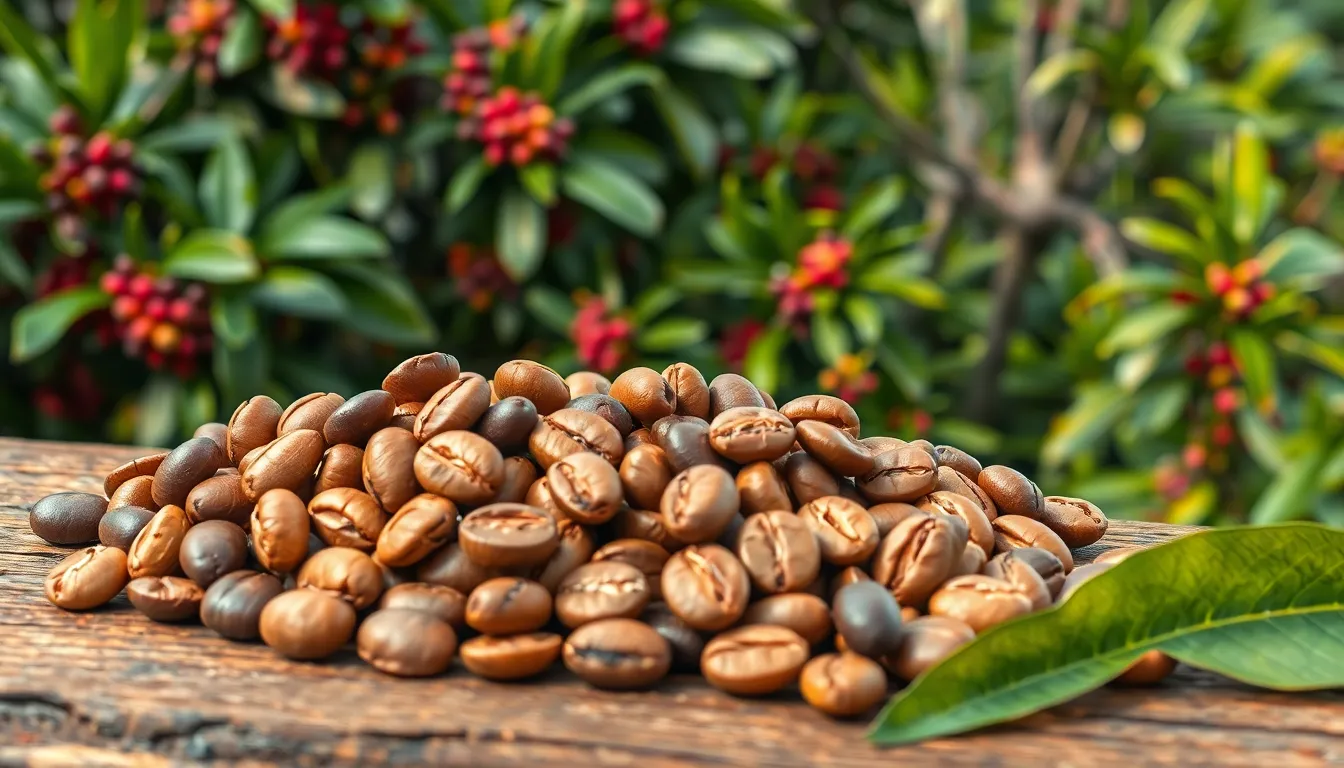Coffee isn’t just a drink; it’s a global phenomenon that fuels mornings and sparks creativity. From the bustling streets of Seattle to the tranquil cafes of Paris, coffee culture connects people across continents. It’s the magical potion that transforms sleepy faces into vibrant conversations and inspires countless first dates and brainstorming sessions.
But let’s be real: coffee is more than just a caffeine fix. It’s a rich tapestry woven with stories of farmers, roasters, and baristas who pour their heart and soul into every cup. As coffee lovers sip their favorite brews, they’re part of a worldwide community that celebrates flavor, tradition, and the occasional coffee spill. So grab your favorite mug and prepare to explore the fascinating world of coffee global—where every sip tells a story and every bean has a journey.
Table of Contents
ToggleOverview of Coffee Global
Coffee transcends mere consumption; it embodies a cultural and economic powerhouse. This beverage influences social interactions and drives entire industries worldwide.
Importance of Coffee in the World Economy
Coffee plays a critical role in the global economy, generating approximately $100 billion annually. Significant employment opportunities arise, with around 25 million people directly involved in coffee cultivation. Countries like Brazil, Vietnam, and Colombia contribute substantially to this market. Farmers rely on coffee as their primary source of income, securing livelihoods in developing regions. Moreover, the global supply chain encompasses not just farmers but also processors, exporters, and retailers. Economic stability flourishes in coffee-producing nations due to the industry’s resilience against market fluctuations.
Major Coffee-Producing Regions
The primary coffee-producing regions fall within the Coffee Belt, which spans between the Tropics of Cancer and Capricorn. Brazil dominates as the largest producer, accounting for about 37% of global coffee production. Vietnam follows closely, specializing in robusta coffee, which forms a significant portion of exports. Colombia’s reputation for premium arabica coffee adds to its prominence in the coffee sector. Other notable producers include Ethiopia, Guatemala, and Honduras, each contributing unique flavors and characteristics to the market. This diversity in production supports a rich tapestry of coffee experiences enjoyed around the globe.
Types of Coffee Beans

Coffee beans fall into several categories, primarily defined by species. Two major types dominate the global market: Arabica and Robusta.
Arabica vs. Robusta
Arabica beans account for approximately 60-70% of the global coffee production. These beans grow at higher altitudes and offer sweeter flavors with a delicate acidity. Farmers cultivate Arabica in regions like Colombia and Ethiopia, where ideal conditions foster their unique taste profiles. In contrast, Robusta beans possess a bolder flavor, often described as earthy or nutty. They thrive at lower altitudes and are typically easier to grow, making them more resilient to pests and diseases. Robusta comprises about 30-40% of the market, with major production occurring in Vietnam and Brazil, where farmers appreciate their higher yield.
Specialty Coffee Varieties
Specialty coffee varieties include unique types of Arabica bean cultivars. These varieties showcase distinct flavors and aromas, often reflecting their terroir. Examples include Geisha, known for its floral notes, and Bourbon, which features sweetness and complexity. Producers eligible for specialty status must meet rigorous quality standards, ensuring a highly enjoyable cup. The Specialty Coffee Association (SCA) ranks coffees based on specific attributes, reinforcing the dedication to artisanal brewing. As consumer interest in gourmet coffee grows, the demand for these specialty varieties expands, leading to vibrant global markets and new experiences for coffee enthusiasts.
Coffee Cultivation and Production
Coffee cultivation and production involve various methods that impact quality, sustainability, and farmer livelihoods. Understanding these practices and challenges is essential for appreciating coffee’s global influence.
Sustainable Coffee Farming Practices
Sustainable coffee farming practices promote environmental preservation and economic viability. Techniques like shade-grown coffee protect biodiversity while enhancing bean quality. Many farmers implement agroforestry systems, which integrate coffee with other crops, improving soil health and resilience. Certification programs, such as Fair Trade and Rainforest Alliance, encourage responsible farming and provide farmers access to premium markets. Adoption of organic farming methods reduces chemical use, supporting healthier ecosystems. These practices benefit not only producers but also consumers who value ethically sourced coffee.
Challenges in Coffee Production
Challenges in coffee production significantly affect global supply and pricing. Climate change poses a major threat, with rising temperatures and unpredictable rainfall impacting harvests. Pests and diseases, such as coffee leaf rust, also jeopardize crop yields. Farmers in key regions often lack access to resources and technology that promote resilience. Economic pressures, including fluctuating market prices, contribute to instability in livelihoods for millions. Furthermore, aging coffee plantations require rejuvenation, which entails investment and risk management. Addressing these challenges is crucial for maintaining the sustainability of the coffee industry.
Coffee Consumption Trends
Coffee consumption continues to evolve globally, reflecting changing preferences and cultural shifts. Understanding these trends provides insight into how coffee connects people around the world.
Global Coffee Consumption Statistics
Approximately 2.25 billion cups of coffee are consumed daily worldwide. The United States remains a leading consumer, with around 400 million cups enjoyed daily. Europe follows closely, with countries like Germany and France demonstrating significant demand. Coffee consumption has increased by 14% over the past decade, primarily driven by the rising popularity of specialty brews. Millennials enthusiastically embrace third-wave coffee, valuing quality and unique flavor profiles. In 2021, coffee’s global market value reached around $100 billion, showcasing its enduring appeal and economic importance.
Emerging Markets for Coffee
Emerging markets indicate a growing enthusiasm for coffee beyond traditional strongholds. Countries such as China and India are experiencing rapid growth in coffee consumption, fueled by the younger generations’ changing habits. In China, coffee consumption increased by 15% annually from 2015 to 2020, highlighting a shift towards modern café culture. India also shows promising growth, with an estimated 8% increase in coffee drinkers from 2020 to 2021. Specialty coffee shops and cafes flourish in urban areas, catering to diverse tastes. This trend emphasizes global diversification, bringing various cultures and flavors into the coffee experience.
Conclusion
Coffee transcends mere consumption; it embodies a rich tapestry of culture and community. Each cup represents a journey that connects farmers, roasters, and drinkers around the globe. As the industry continues to evolve, its economic impact and cultural significance remain undeniable.
The rising interest in specialty coffee and sustainable practices showcases a commitment to quality and environmental stewardship. While challenges persist, the resilience of the coffee industry reflects its vital role in supporting livelihoods and fostering connections.
In every sip, there’s a story waiting to be discovered, reminding everyone of coffee’s unique ability to unite diverse cultures and experiences.





